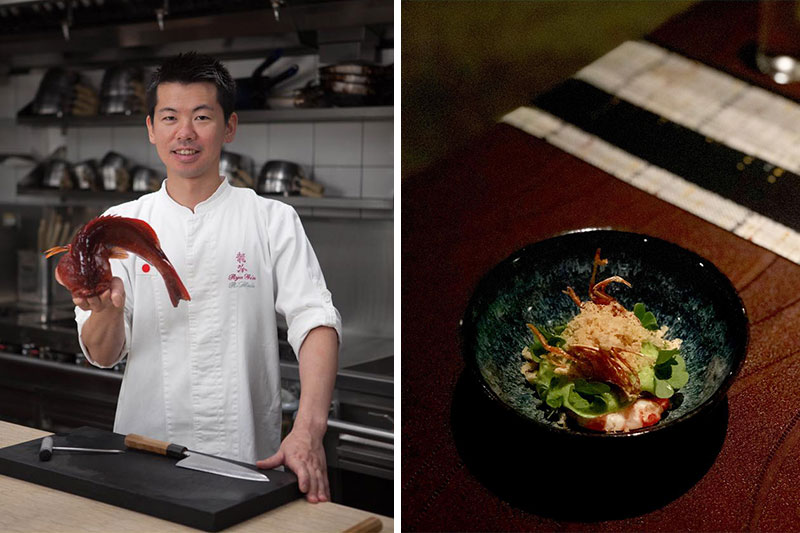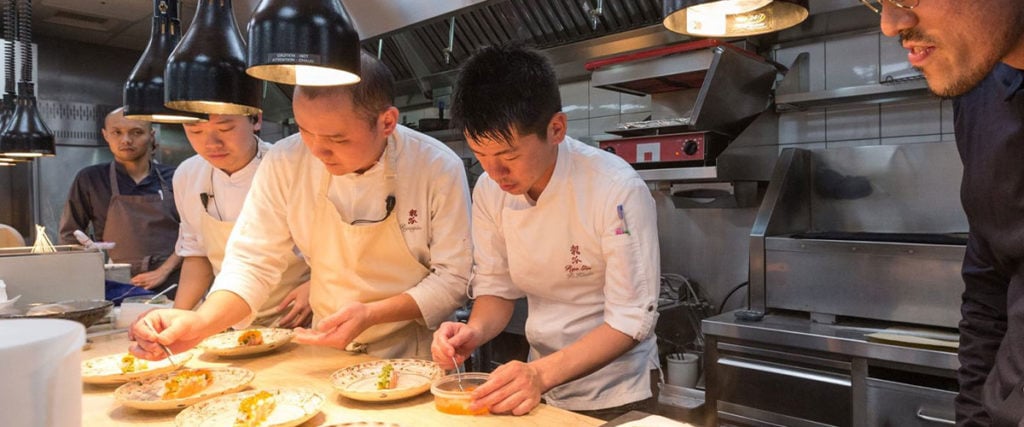Meet Ryohei Hieda, the Michelin Star-winning chef and Kaiseki King taking Japan’s most elaborate cuisine to Taiwan – and breaking the rules in a whole new way.
In 2008, chef Ryohei Hieda stumbled across an article featuring legendary Japanese chef Seiji Yamamoto, sparking a lifelong career dedicated to Kaiseki, the most demanding of Japanese cuisine. “I was surprised and deeply moved by his dish presentation, his wonderful sense in how he used the instruments, and how he created the space on the plate,” says the modern Japanese cooking maestro. Fast forward to today and Chef Hieda heads up one of his idol’s Michelin-starred restaurant’s offshoots Shoun RyuGin in Taipei, with a spot on Asia’s Best 50 Restaurants List and a two-star Michelin rating under his belt. He talked us through his tale, from aimless teen to Kaiseki King breaking the rules in a different way.

Born to a carpenter family in Kyushu, Japan, Chef Hieda was once a self-professed ‘aimless’ teenager. “I couldn’t find what I wanted to do in the future and I didn’t go to college,” he says. But fate has a way of intervening. His lack of direction led him to work in a local izakaya. “The chef who worked there was very passionate and I thought it would be interesting to live in the culinary world,” he recalls. His new calling then drove him to apprentice at the prestigious Kyoto restaurant Kappou Nakagawa at the tender age of 19 before returning home to Kyushu to work at the famed restaurant Itaru.
Over the years, Chef Hieda demonstrated his remarkable aptitude for cooking at some of the world’s most revered Michelin-starred concepts around the world, including French-inspired Benu and Manresa in the US. But, for him, it was his time at Nihonryori RyuGin in Tokyo’s Roppongi district that was by far the most important. “It shaped my approach to cooking in a way that challenges me not to be limited by traditional rules,” he explains.

Those rules – or rather lack thereof – relate to Kaiseki, the multi-course concept long considered the quintessence of Japanese haute cuisine. Built around seasonal produce, it is a way of cooking that’s a manifestation of the country’s acute attention to detail and richness of nature. “The philosophy of Japanese cuisine is to express the land and seasons through dishes, but what I learned at RyuGin was a brand new way of doing it,” he says. As Japan’s highest form of culinary art with a history dating back centuries, a Kaiseki meal is normally governed by hundreds of rules: sashimi should be served in odd numbers; round food should be served in square vessels, etc. But, from Chef Yamamoto, the young apprentice learned that the most confident expression of Kaiseki mastery could be found in the subversion of rules.
In 2014 when Hieda was appointed by Chef Yamamoto to take the helm of his kitchen at Shoun Ryugin in Taiwan, he embarked upon a new journey. Instead of sticking to imported ingredients from Japan, Chef Hieda chose to focus his culinary expertise on the island’s bountiful produce, spending months combing through the territory to understand the inherent characteristics of Taiwan’s local harvest, scouting and establishing relationships with local producers. “Cooking does not start without good ingredients. To research and understand the characteristics of the ingredients before cooking is a must,” he says.

Even now, the chef still sources his ingredients daily from local markets – from his sweet potato leaves to tilefish, Buddha’s hand citron to mullet roe. While it may have been a challenge to begin with for the Nagasaki native, Chef Hieda maintains that it’s one of his favourite experiences. “It’s very difficult to live as a chef if you cannot enjoy the procurement of ingredients and the building of networks,” he says. His intricate dishes, which use more than 90% Taiwanese ingredients, exalt Taiwan’s distinct seasons, serving not only to take Kaiseki to Taiwan, but to reframe Japanese cuisine through a different lens. “I want to create Japanese cuisine that Taiwanese people can call their own – one that can’t be created elsewhere.” With his award-winning restaurant, he’s surely doing that.
Related Articles
Taiwanese Farming Meets Scandinavian Dining
Shane Osborn: The Legendary Netflix Chef on His Newest Solo Venture





